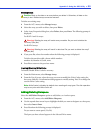
Appendix C: Using the ARC Utility ● 64
To assign properties to the new array:
1 In the Array Properties menu, select an array type, then press Enter.
Only the available array types, RAID 0, 1, and 10 are displayed. RAID 0 and 1 requires two
to four drives. RAID 10 requires a minimum of four disk drives.
2 Optional: Type a label of no more than 15 characters for the array, then press Enter.
3 For RAID 0, select the desired stripe size. Available stripe sizes are 16, 32, and 64 KB
(default).
Note:
It is recommended that you do not change the default.
4
The options under Create RAID Via allows you to select between the different creation
methods for RAID 0, 1, and 10. The following table gives examples of when each is
appropriate.
Note:
● Before adding a new drive to an array, back up any data contained on the new drive.
Otherwise, all data will be lost.
● Only disk drives that were previously configured as simple volumes can be used for
RAID 0 or 1 migration when the single/source drive has data on it. See Configuring
Disk Drives on page 67 to create a simple volume.
● If you stop the build or clear process on a RAID 1 from ACU, you can restart it by
pressing Ctrl+R.
● A RAID 1 and 10 created using the Quick Init option may return some data
miscompares if you later run a consistency check. This is normal and is not a cause for
concern.
● If you stop the migration process on a RAID 0, you can restart it by pressing Ctrl+R.
● To modify the Write Cache setting for an array, press Ctrl+W.
● The ACU allows you to use drives of different sizes in a RAID 1. However, during a
build operation, only the smaller drive can be selected as the source drive.
RAID
Level
Create
RAID Via
When Appropriate
RAID 0 Quick Init Creating a RAID 0 on new drives.
RAID 0 Migrate Creating a RAID 0 and you want to preserve data on an existing
drive. You will be asked to select the source drive. The contents
of the source drive are preserved and any data on the new drive
is lost.
RAID 1 Build Creating a RAID 1 and you want to preserve data on an existing
drive. You will be asked to select the source drive. The contents
of the source drive are preserved and any data on the new drive
is lost.
RAID 1,
10
Clear Creating a RAID 1 or 10 on new drives, or when you want to
ensure that the new array contains no existing data.
RAID 1,
10
Quick Init Fastest way to create a RAID 1 or 10. Appropriate when using a
new drive.


















